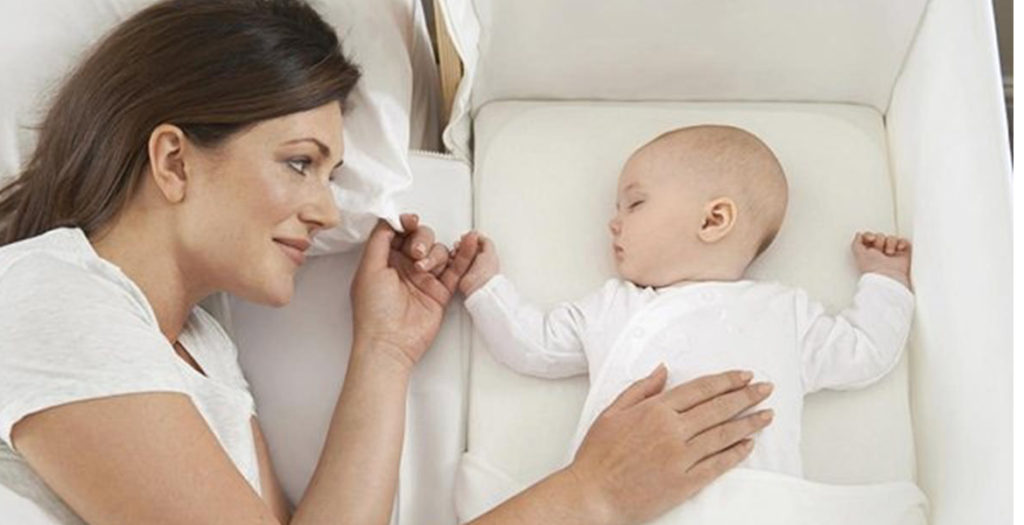by Sally J. Hall
You may have heard that you should have your baby in your own room with you at night for the first six months of their life. This is because babies younger than this are more at risk of a condition called Sudden Infant Death Syndrome (SIDS) or Cot Death.
You should also be aware of the safest way for your baby to sleep and you can read about that here. Your baby should be with you when they sleep no matter where you are – so in your bedroom at night and with you during daytime naps too, in a crib or cot, or in their pushchair if you’re out with the seat down or in a carrycot.
You may also have heard of co-sleeping, which is when you have your baby actually in your bed with you. Many parents love this as it has the advantage of closeness and skin-to-skin contact and it is also much easier when breastfeeding, as you don’t have to disturb your own rest by getting up out of bed and going to your baby.
However, there are times when this might not be safe, so make sure you know how to co-sleep safely with your little one.
When is co-sleeping not safe?
Some kinds of co-sleeping increase the risk of SIDS, for example falling asleep on a chair or sofa with your baby. There is a risk that your baby will suffocate or overheat. The risk is the same during the day as at night, so if you think you might fall asleep during or after a feed, make sure you put your baby in their crib or cot before you nod off.
There are other times when it’s not safe to share your bed with your baby:
- If you have been drinking or taken drugs or medicine that may make you more sleepy than usual. You may roll onto your baby or forget they are in bed with you.
- If you smoke – even e-cigarettes.
- If your baby is younger than three months or if your baby was very small at birth or premature. If he has been in the Special Care Baby Unit, you should not co-sleep for a few months until he is bigger.
- If you are very tired – more than usual. You may sleep so deeply that you are not aware of your baby in bed with you.
How can I make co-sleeping safer?
If none of these risks apply to you, co-sleeping can be safe and many parents love it. There are some measures you can take to ensure co-sleeping is safe.
Have a flat, firm mattress and make sure it is in good condition, with no sagging or tears. It should not be too soft and it should fit well on the frame or base of the bed, with no gaps for a little one to get trapped in. You should never choose a waterbed to co-sleep in, not any kind of airbed or beanbag.
Make sure the bedding is not too hot and is well adjusted
The risk of SIDS is increased if your baby overheats or if their head gets covered with bedding. Choose a lightweight duvet or preferably sheets and blankets and have them around your waist, so that it does no come above your baby’s shoulders. Keep pillows well away from him – they should not be used to prevent rolling off the bed, as his face could become pressed against it and he could be smothered.
Alternative, choose a baby sleeping bag of the correct Tog for the temperature of the room BUT don’t the cover him with your bedding too.
Make sure your room is at a comfortable temperature as explained on our safe sleeping page. Feel the back of your baby’s neck to check if he is too hot or cold – not their hands, which are often much colder than their body.
Sleeping with your baby
Have your baby lying next to you, while you lie on your side. Curl up around your baby, with the arm that is next to the bed above their head and your legs tucked up beneath his legs. This C-shape will protect your baby and it’s also a great position for you to breastfeed during the night.
Have a bedside crib
So that you both get some sleeping space and your baby is safe, invest in a co-sleeping crib. This fits against your own bed and has a drop-down side that you can lower when it’s time for a feed or a cuddle, then raise when you want your baby in their own crib. Make sure that you choose a model that has a side that lowers completely flat, with no ridge your baby might get trapped over.
- When you are not in bed, never leave your baby there.
- Make sure you always put him back in his own crib or cot.
The bed’s not big enough
If you find that sleeping with your partner and the baby is too cramped, you might want to invest in a bigger bed. Alternatively, you or your partner may decide to sleep in a different room for a while – some couples take it in turns so each gets some sleep. If your partner is working, they may find it easier to get some sleep in a different room so that they are fresh for work. Make sure you get a lie-in at the weekends though!
Whatever you decide to do must be the best choice for you and your family. Don’t let the advice of others put you off and if you follow our safety tips, you should all be able to get a good night’s sleep!

